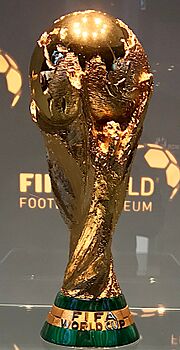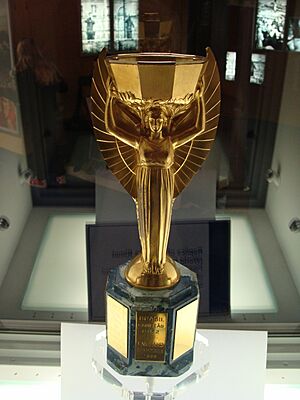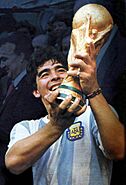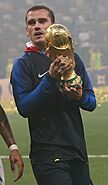FIFA World Cup Trophy facts for kids
Quick facts for kids FIFA World Cup Trophy |
|
|---|---|

FIFA World Cup Trophy
|
|
| Given for | Winning the FIFA World Cup |
| Presented by | FIFA |
| History | |
| First award | 1930 (Jules Rimet Trophy) 1974 (FIFA World Cup Trophy) |
| First winner |
|
| Most wins | |
| Most recent | |
| Website | fifa.com |
The FIFA World Cup Trophy is a famous golden award given to the team that wins the FIFA World Cup football tournament. Since the World Cup started in 1930, there have been two different trophies. The first one was called the Jules Rimet Trophy, used from 1930 to 1970. After that, the FIFA World Cup Trophy has been used from 1974 until today. The current trophy is very valuable, costing around $242,700 to make.
The first trophy was originally named Victory. It was later renamed to honor Jules Rimet, who was the president of FIFA. This trophy was made of gold-plated silver and had a base of lapis lazuli, a blue stone. It showed Nike, the Greek goddess of victory. The Brazilian team won this trophy permanently in 1970 after winning their third World Cup. This meant a new trophy had to be made. Sadly, the original Jules Rimet Trophy was stolen in 1983 and has never been found.
The new trophy, known as the "FIFA World Cup Trophy", was first used in 1974. It is made of 18-karat gold and has green malachite bands on its base. The trophy stands about 36.8 centimeters (14.5 inches) tall and weighs 6.175 kilograms (13.6 pounds). It was created by an Italian company called GDE Bertoni. The design shows two human figures holding up the Earth. The team that currently holds the trophy is Argentina, who won the 2022 World Cup. The real trophy is kept at the FIFA World Football Museum in Zürich, Switzerland. It only leaves the museum for special events. World Cup winners receive a gold-plated bronze copy of the trophy. They get to keep this copy forever.
Only a few special people are allowed to touch the real trophy with their bare hands. This includes players and managers who have won the World Cup, leaders of countries, and officials from FIFA.
The Jules Rimet Trophy

The Jules Rimet Cup was the very first trophy for the FIFA World Cup. It was first called "Victory" but was usually just known as the World Cup. In 1946, it was renamed to honor Jules Rimet. He was the FIFA President who helped start the competition in 1929. A French artist named Abel Lafleur designed it. It was made of gold-plated silver and had a base made of lapis lazuli. In 1954, the base was made taller to fit more names of winning teams.
The trophy was 35 centimeters (14 inches) tall and weighed 3.8 kilograms (8.4 pounds). It looked like a cup with ten sides, held up by a winged figure. This figure represented Nike, the ancient Greek goddess of victory. The Jules Rimet Trophy traveled to Uruguay for the first FIFA World Cup in 1930. It went on a ship called the Conte Verde. The first team to win this trophy was Uruguay in the 1930 World Cup.

During World War II, the trophy was held by 1938 champion Italy. An Italian football official named Ottorino Barassi secretly moved the trophy from a bank. He hid it in a shoe-box under his bed to stop the Nazis from taking it. In the 1958 FIFA World Cup in Sweden, a new tradition began. The Brazilian captain, Hilderaldo Bellini, lifted the trophy high in the air for photographers. Since then, every winning captain has done the same.
On March 20, 1966, just four months before the 1966 FIFA World Cup in England, the trophy was stolen. It was taken during a public display in London. Seven days later, a black and white dog named Pickles found it. The trophy was wrapped in newspaper and hidden under a garden hedge.
To be safe, the English Football Association secretly made a copy of the trophy. They used this copy for displays instead of the real one. FIFA had not given them permission to make a copy. So, after the real trophy was returned to FIFA for the 1970 competition, the copy had to be hidden. For many years, it was kept under its creator's bed. This copy was later sold at an auction in 1997. FIFA bought it for £254,500. FIFA confirmed it was indeed a copy. Today, this replica is on display at the English National Football Museum in Manchester.
The Brazilian team won the World Cup for the third time in 1970. This meant they got to keep the real trophy forever, as Jules Rimet had decided in 1930. It was put on display at the Brazilian Football Confederation building in Rio de Janeiro. It was kept in a cabinet with bullet-proof glass.
On December 19, 1983, the trophy was stolen again. The back of the cabinet was forced open, and the cup was taken. Four men were found guilty of the crime, but they were not present for their trial. The trophy has never been found. Many people believe it was melted down and sold as gold. However, some think it might still exist, sold on the black market. Only one small part of the Jules Rimet Trophy has been found: its original base. FIFA had kept this part in a basement in Zürich.
The Brazilian Football Confederation had a new copy made. This copy was given to the Brazilian president in 1984.
The New Trophy
FIFA asked for a new trophy for the 1974 World Cup. Many artists from different countries sent in their ideas. An Italian artist named Silvio Gazzaniga won the competition. This trophy is about 36.5 centimeters (14.4 inches) tall. It is made of 6.175 kilograms (13.6 pounds) of 18-karat gold. Its base is 13 centimeters (5.1 inches) wide and has two layers of malachite. Scientists say the trophy is hollow. If it were solid gold, it would weigh 70 to 80 kilograms (150 to 180 pounds), which would be too heavy to lift! The company that made it has confirmed it is hollow.
The trophy was made by GDE Bertoni in Italy. It shows two human figures holding up the Earth. Gazzaniga described his design: "The lines start from the base and rise in spirals, reaching out to hold the world. From the strong, flowing shape of the sculpture, you can see two athletes at the exciting moment of victory."
The winning team used to keep the trophy until the next tournament's final draw. But that is not how it works anymore. Now, the winners get a bronze copy that is gold-plated. This copy is not solid gold. Also, teams that win three times get to keep this replica instead of the original trophy. Germany was the first country to win the new trophy three times when they won the 2014 FIFA World Cup. Argentina became the second country after their third win in Qatar at the 2022 FIFA World Cup.
The words "FIFA World Cup" are engraved on the trophy's base. After the 1994 FIFA World Cup, a plate was added to the bottom of the trophy. The names of the winning countries are engraved on this plate. You cannot see the names when the trophy is standing upright. The engravings show the year and the winning country's name in its own language. For example, "1974 Deutschland" for Germany or "1994 Brasil" for Brazil. In 2010, the name was engraved as "2010 Spain" in English, but this was corrected later. As of 2022, twelve winners have their names on the base. The plate is changed after each World Cup, and the names are arranged in a spiral to make room for future winners.
The original trophy is now kept permanently at the FIFA World Football Museum in Zürich, Switzerland. It only leaves the museum for its special FIFA World Cup Trophy Tour. It is also present at the draw for the next World Cup, and on the field for the World Cup's opening game and final match. The FIFA World Cup Trophy Tour started for the 2006 FIFA World Cup competition.
World Cup Winners
Here is a list of all the teams that have won the FIFA World Cup.
Jules Rimet Trophy Winners
 Brazil – 1958, 1962, 1970
Brazil – 1958, 1962, 1970 Uruguay – 1930, 1950
Uruguay – 1930, 1950 Italy – 1934, 1938
Italy – 1934, 1938 West Germany – 1954
West Germany – 1954 England – 1966
England – 1966
FIFA World Cup Trophy Winners
 West Germany /
West Germany /  Germany – 1974, 1990, 2014
Germany – 1974, 1990, 2014 Argentina – 1978, 1986, 2022
Argentina – 1978, 1986, 2022 Italy – 1982, 2006
Italy – 1982, 2006 Brazil – 1994, 2002
Brazil – 1994, 2002 France – 1998, 2018
France – 1998, 2018 Spain – 2010
Spain – 2010
See also
 In Spanish: Trofeo de la Copa Mundial de Fútbol para niños
In Spanish: Trofeo de la Copa Mundial de Fútbol para niños
- FIFA Women's World Cup trophy
- FIFA Champions Badge



